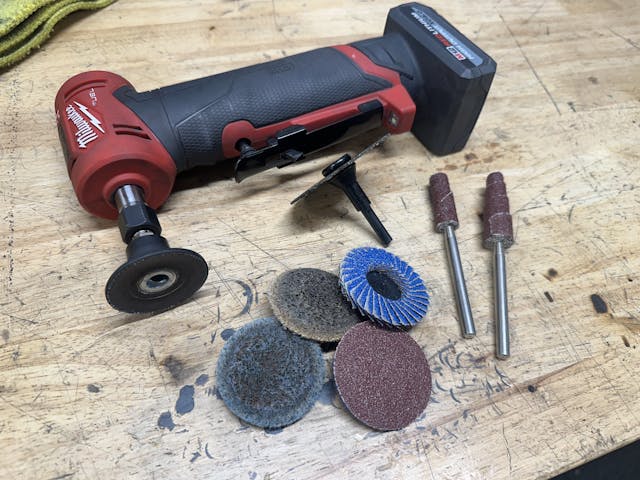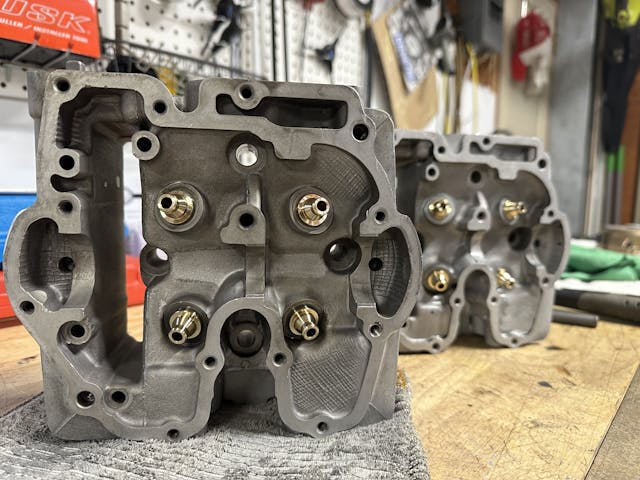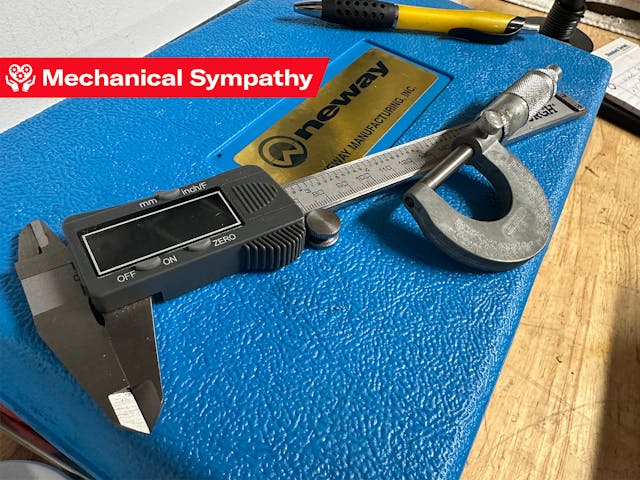The Blessing and Curse of Precision
During a recent garage chat with a friend about tools, I finally talked myself into purchasing a Milwaukee M12 right-angle die grinder. It’s a great upgrade to my current shop: I really enjoy the handiness of a die grinder with Roloc discs for cleaning and the small amount of fabrication that pops up in my projects, but I am too cheap to make space or budget for the air compressor it would take to run hungry tools like a die grinder. While air tools absolutely have their place—I’ll still make trips over to a friend’s shop to do the next porting job—this little battery-powered tool has been a wonderful stopgap. Compromise when understood and expected rarely feels like such.
Adding this die grinder to my tool set forced me to rearrange a few drawers in my toolbox. In them I found the evolution of my capability to cut, sand, and grind: a set of mismatched files from an estate sale, bent and scraggly wire brushes, wire-wheel attachments for a drill, a corded angle grinder, a cordless angle grinder, and now a tidy little die grinder—all added in that order.

At some point, as you develop the skills to use the tools you have, a set of cascading switches trip in your brain. You want to do the job a little cleaner next time, or for the components to fit up better—in short, you want less evidence that a repair was done at all. When rebuilding my 1989 Honda XR250R during the year that I raced it, I took an odd amount of care to make it appear as though I hadn’t taken the thing apart seven times in as many months. Keeping hardware from rounding off doesn’t really require some crazy amount of care, but we have likely all been under a hood where the last person there certainly didn’t take the time.
The evolution of my toolbox’s contents happened incrementally rather than in big steps. Over 15 years passed between my first project car and when I bought a set of digital calipers. For a good number of years I worked with a single hammer, basic socket set, and some screw drivers; I did full motorcycle rebuilds with not much more. The most noticeable changes were not those in tool count but in quality: Tools that allowed me to perform more delicate work.
Each addition improved my ability to remove or address flaws or problems with increasing power and speed—and most importantly, with increasing precision. I could focus more and more on the process of creating a higher-quality finished product. I used my time more efficiently because the tool was helping me, not holding me back. Rather than putting a ceiling on my capability, the right tools enabled the more advanced ideas and plans in my brain to come to reality.

If you can measure something, you can usually perfect it. Years ago a tape measure was appropriate for the work I did; now, the projects on my bench require the ability to read a Vernier scale on a micrometer. While it is possible to work on vintage machines without being slowly strung out to a line of atoms entering the black hole that is true precision, there will always be a ceiling to what you can do with basic tools. It is possible to assembling an engine that lasts a long time using only rusty tools you found on the side of the highway; but that rebuild will involve a lot of luck.
Anything worth doing requires some level of effort and carries at least a little risk. The strange thing is that measuring is the most likely place for human error to enter and wreak havoc on your project. Transposing a few numbers in my head led to throwing out a couple chunks of aluminum and about an hour of work last time I was standing in front of a lathe.
Working on projects can be frustrating for any number of reasons, but occasionally that frustration reflects a standard of quality we happily imposed upon ourselves. Working on project cars is like running on a treadmill. It is possible to quantify how far you have come by the hours spent, the distance traveled, or the average pace per mile, and measuring and quantifying that progress made can be rewarding at the right times; but so often we forget to look back at how we have improved—and how much smarter we’ve become along the way. After all, now I can measure my project progress down to the thousandth of an inch.
***
Check out the Hagerty Media homepage so you don’t miss a single story, or better yet, bookmark it. To get our best stories delivered right to your inbox, subscribe to our newsletters.



The quality of the work I output as I get older is no more prevalent than comparing audio equipment installs of my teenage years to now. Matt Anderson is running into his youth now with his old teenage ride and the hackery we define as “good enough” in our youth.
I find now the two things that limit the precision I desire vs “just get it running again” comes down to available time and the hardware available to me.
For example, I’ve been adding door speakers and door panels from a later model w126 to my ’86. The door does not have the provisions to mount the speaker assembly. I WANT to install nutserts, studs, and make little stand off spacers. However, time and available hardware saw me use drilled holes, machine screws, and washers. It all sits behind a grille, but part of me battles with “good enough” vs “correct”.
I tell myself I’ll fix it proper when I have more time, but we all know nothing is more permanent than a temporary fix.
I hear ya, Colton. My father was one of the originators of the phrase “good enough for who it’s for”, and I learned much from him. I never was much of a perfectionist, and I kind of lack patience in some things – like the “get it running” bug that has bit you. I’m sort of in the camp of if I turn the key and it starts, I’m happy. On the bright side, however, it’s guys like us that keep the self-tapping screw manufacturers in business, right?
Or, Better is the Enemy of Done
Great piece, Kyle. Electric tools have definitely changed the way I work in a lot of different ways.
And having precise measuring tools on hand can seem like you won’t get a ton of value out of them when you purchase them…but having a dial indicator at 11P when something needs to be checked is pretty dang handy!
My great uncle who was born in the 1800’s became an engineer in the early part of the auto industry. He was part of the group that designed the first tandem axle trucks For Goodyear’s Wingfoot Express trucks.
He went on to GM and worked there as a lead engineer fromt he 20’s to around 1960. He saw it all in the 20th century not only in auto advancements but even man in flight and on the moon.
What was his claim as the greatest thing that happened? The SAE standards for fasteners. He said until the standards were made they had a royal mess on their hands. Everything has to have a special tool and you seldom could cross the tools. assembly in plants was difficult too. Suppliers could bring you something different all the time.
The precision of these parts made a difference in the speed we advanced in the century. It is likely flight let alone going to the moon may have not happened as early or at all.
It is the little things that make a difference and when you measure think about that. It can make the difference between success and failure or winning and losing.
2 thousandths of an inch could make our soap box derby car a winner if it was right and a big loser if it was off on the alignment. The same applies to the life of an engine.
For anyone interested in measuring, mechanical standardization, manufacturing, and how these wonderful objects in our garages and homes were developed, I highly recommend Simon Winchester’s book “The Perfectionists”. Surprisingly easy read, fascinating, with several surprises along the way.
I was a heavy engine mechanic at an Oldsmobile dealership in the mid 80’s. To Kyle’s point, I was very meticulous about putting the correct fasteners in the correct location just like they came out of the factory. I was pin headed enough about this that I had a customer argue that I did not pull his engine and replace a crankshaft. Fortunately my service manage took Polaroids to document the process.
The availability of reasonably priced (cheap even) measuring instruments has made precision more attainable for the DIYer. I have several drawers in my toolbox dedicated to inside and outside micrometers (1-5 Inch), numerous vernier and dial calipers that cost real money when I bought them off of the Snap-On truck back in the day. I use them occasionally just so I can prove to myself that I can still read the scales but its hard to beat my $30 Harbor Freight vernier that can give me an easy to read measurement in english, metric, digital, or fractions.
Kyle unless you misspoke (miswrote?), you have even more capability than you realize: that vernier scale on your micrometer reads ten-thousandths of an inch. At that scale you can really see things move around with small temperature changes.
The scale might be that precise, but I’m not yet! After spending all this weekend playing with precision tools I have come to realize I really need some training or guidance on some machining practices. It’s really easy to get the hang of things without really knowing what you are doing these days…